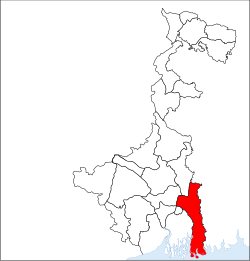North 24 parganas
|
North 24 Parganas district উত্তর চব্বিশ পরগণা জেলা |
|
|---|---|
| District of West Bengal | |
 Location of North 24 Parganas district in West Bengal |
|
| Country | India |
| State | West Bengal |
| Administrative division | Presidency |
| Headquarters | Barasat |
| Government | |
| • Lok Sabha constituencies | Bangaon, Barrackpore, Dum Dum, Barasat, Basirhat |
| • Assembly seats | Bagda, Bangaon Uttar, Bangaon Dakshin, Gaighata, Swarupnagar, Baduria, Habra, Ashoknagar, Amdanga, Bijpur, Naihati, Bhatpara, Jagatdal, Noapara, Barrackpore, Khardaha, Dum Dum Uttar, Panihati, Kamarhati, Baranagar, Dum Dum, Rajarhat New Town, Bidhannagar, Rajarhat Gopalpur, Madhyamgram, Barasat, Deganga, Haroa, Minakhan, Sandeshkhali, Basirhat Dakshin, Basirhat Uttar, Hingalganj |
| Area | |
| • Total | 4,094 km2 (1,581 sq mi) |
| Population (2011) | |
| • Total | 10,082,852 |
| • Density | 2,500/km2 (6,400/sq mi) |
| Demographics | |
| • Literacy | 84.95 percent |
| • Sex ratio | 949 |
| Major highways | NH 34, NH 35 |
| Average annual precipitation | 1579 mm |
| Website | Official website |
North 24 Parganas district (Pron: pɔrɡɔnɔs) is a district in southern West Bengal, of eastern India. North 24 Parganas extends in the [tropical zone] from latitude 22º11'6" north to 23º15'2" north and from longitude 88º20' east to 89º5' east. It is bordered to Nadia by north, to Bangladesh (Khulna Division) by north and east, to South 24 Parganas and Kolkata by south and to Kolkata, Howrah and Hoogly by west. Barasat is the district headquarters of North 24 Parganas.North 24 Parganas is West Bengal's most populous district and (following the splitting of the Thane district of Maharashtra in 2014) the most populated district in the whole of India. It is also the tenth-largest district in the State by area.
According to Ptolemy's Treatise on geography, written in the 2nd Century A.D., the ancient land of Gangaridi was stretched between the rivers Bhagirathi-Hoogly (lower Ganges) and Padma-Meghna. The modern-day 24 Parganas was the southern and the south-eastern territory of that legendary kingdom.
Archaeological excavation at Berachampa village in Deganga PS proves that though the area was not directly attached to the rule of the Guptas, yet it could not shun their cultural influence. Xuanzang (c. 629-685) visited 30 Buddhist Biharas and 100 Hindu Temples in India and some of these were in the Greater 24 Parganas region.
The district was not a part of Shashanka's unified Bengali empire known as Gauda, but it is assumed that the district which was the south-west frontier territory of ancient Bengal, was comprised in under the rule of Dharmapala (estimated c. 770-810). The Pala rule was not quite strong in this part, as no excavation uncovered any of Buddhist Pala antiquities but many Hindu Sena sculptures.
...
Wikipedia
